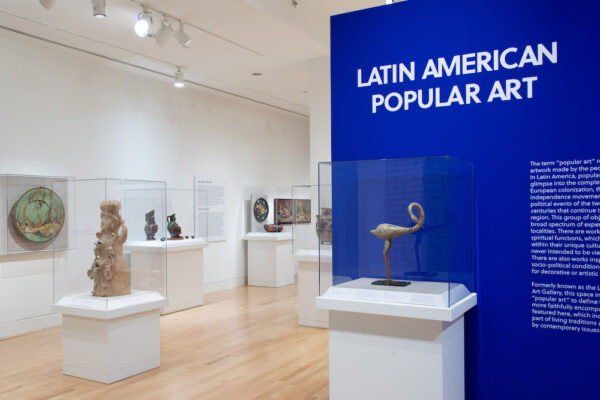
Installation view of Latin American Popular Art Gallery at San Antonio Museum of Art, 2020. All photos courtesy SAMA, by Seale Studios
Para leer este artículo en español, por favor vaya aquí. To read this article in Spanish, please go here.
San Antonio Museum of Art (SAMA) recently re-opened its formerly titled Latin American Folk Art wing as the Latin American Popular Art Gallery. This follows a philosophical perspective shift on the concept and categorization of “folk art” by museums worldwide. For decades “folk” was a mystified term imbued with a colonial gaze — there were often restrictions around what constituted folk art. Works that had contemporary references (say Elvis, Batman, or an astronaut) were not collected. Likewise, works that were commercially sold were ignored by museums and collectors. A “purity” was imposed on indigenous artists that would never be considered for “Western,” or “high art” artists. Global folk art was viewed (by mostly white and male curators) as a Brigadoon utopia of naïve artisanship. The artists were not seen as individuals, but rather merely cogs in the lineage wheel of craft.
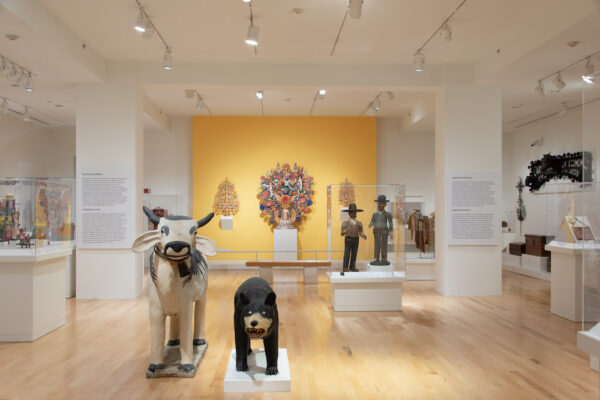
Installation view of Latin American Popular Art Gallery at San Antonio Museum of Art, 2020. All photos courtesy SAMA
The phrase “Popular Art” is a small but important redefinition of the broad and nebulous category of folk art, which, depending on what museum you visit could include: indigenous art, outsider and self-taught art, craft and textile traditions, devotional and religious art outside of an Abrahamic context, and any other works that are not neatly “contemporary” or “classical.” Popular Art is a more flexible, intuitive phrase, that while still bogged down by a High/Low European/Global South dichotomy, moves in the right direction of dismantling hierarchies and mystifying divisions of sanctity and worth.
Dr. Lucía Abramovich, Associate Curator of Latin American Art at SAMA, describes it:
“Popular Art refers to artwork that is made by and for the people. As such, any exhibition of this work must explore and reflect the complexity of experiences that yielded it, from the response to colonization, to the sacred and communal traditions passed through generations, and to creative engagement with contemporary social and political circumstances. The reinstallation of our collection captures some of these motivations and contexts, while also highlighting the incredible artistry and craftsmanship of the works.”
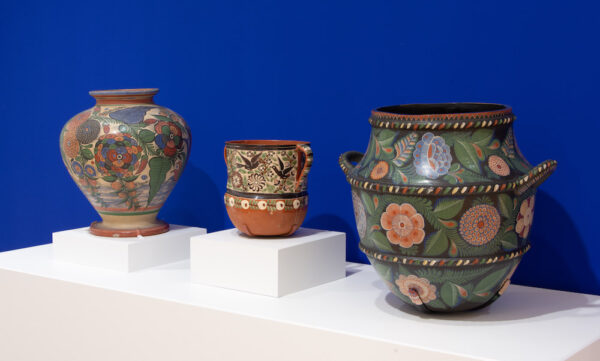
Installation view of Latin American Popular Art Gallery at San Antonio Museum of Art, 2020. All photos courtesy SAMA
SAMA’s Latin American Popular Art Gallery is packed with beautiful, vibrant works representing only a fraction of the museum’s collection, which will be rotated in over the next few years. There is a balance in the works between textiles (blankets, ponchos, and other fabrics), ceramics and sculptures, paintings, and various other media.

Installation view of Latin American Popular Art Gallery at San Antonio Museum of Art, 2020. All photos courtesy SAMA
One of the most spectacular pieces of this “other media” is an intricately embroidered pale saddle from Puebla, circa 1922, by an unknown artist. This exquisite piece appears like the saddle of the hero in some epic silent western shot in cold silver shadows — the saddle for a Zapata or Bolivar liberator — a dense aesthetic latticework of tradition reified into leather and practicality. (After all, despite the beauty of this piece it is a functioning saddle). These aesthetic wonders have a lightness of being, a billowing delight, less encumbered with the heavy, tedious baggage of the tradition of European classical tradition (of course there is much cross-pollination). One can revel in the splendor of popular art without the ellipses of ….at what cost? …and then what?
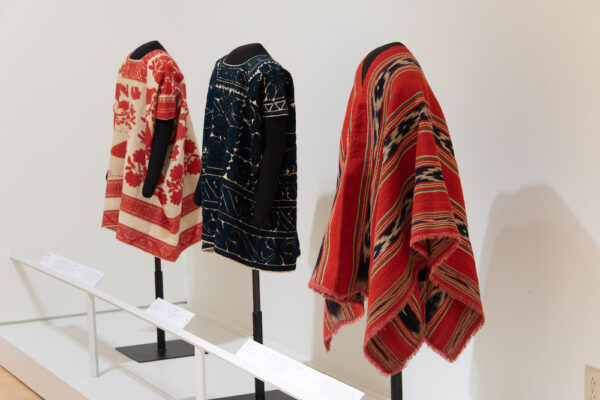
Installation view of Latin American Popular Art Gallery at San Antonio Museum of Art, 2020. All photos courtesy SAMA
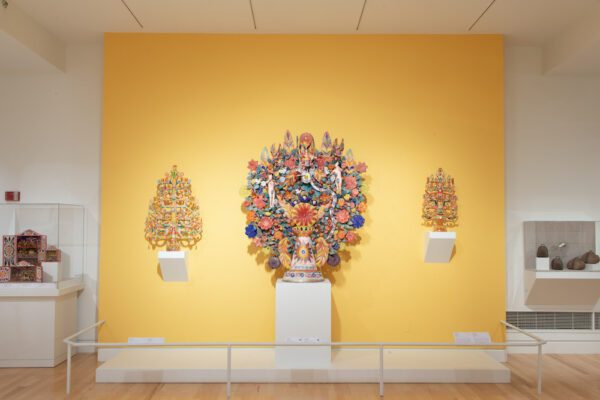
Installation view of Latin American Popular Art Gallery at San Antonio Museum of Art, 2020. All photos courtesy SAMA
Another standout is a tree of life centerpiece from the middle of the 20th century. Again, the artist is unknown. A recurring experience with this popular art is a bittersweet wonder and mystery for all these lost geniuses toiling in forever obscurity, and the purity of their gift — unattached to a name or an ego — floats through time like a paper lantern in a blue night sky. The tree of life centerpieces depict the Garden of Eden with Adam and Eve, angels, the snake, God, and a bounty of blooming flowers. These centerpieces, with their tactility and vertical narrative (the Garden is ascending) physicalize creation; they appear as helices of DNA coiling and intertwining in the black space of nothingness.
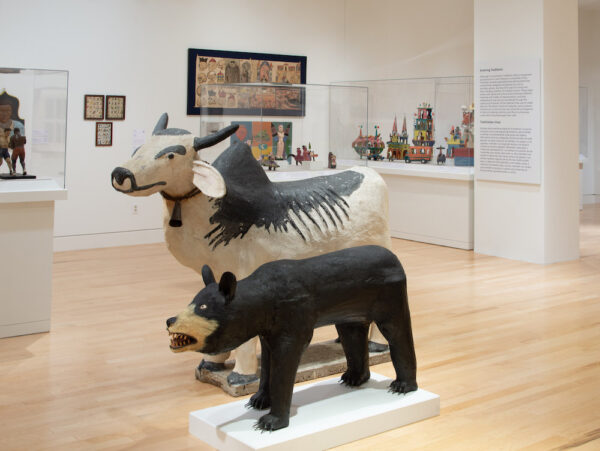
Installation view of Latin American Popular Art Gallery at San Antonio Museum of Art, 2020. All photos courtesy SAMA
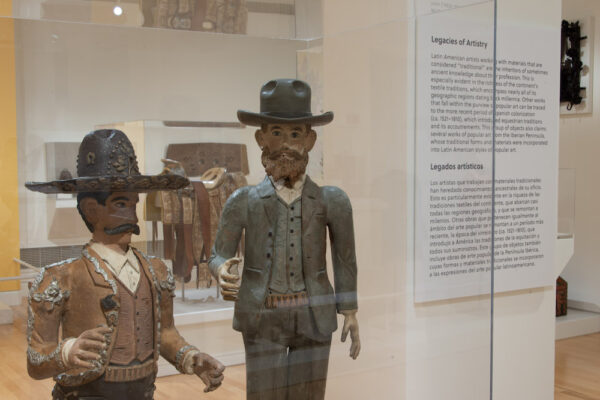
Installation view of Latin American Popular Art Gallery at San Antonio Museum of Art, 2020. All photos courtesy SAMA
Figurative sculptures shine in the exhibit — monkeys, skeletons, bears, cows, boxers, winged angels, vaqueros, revolutionaries. The commonality between these works, whether made from wood, ceramics, papier-mâché, or other materials, is a humorous gaze, a wry distance. Take the ceramic sculptures of Mexican Revolution heroes Venustiano Carranza and Emiliano Zapata by Eulogio Alonso from Puebla in 1938 — they are frozen in mid-movement. Like Kachina dolls, their hands are open, ready to shake or perhaps grapple or draw a pistol; their faces have a bemused blankness as if they know how strange it is to be swept up in the gusts of history. The “folk-artness” of these works is itself a form of demystification of legends. Although obviously made with affection for beloved heroes of freedom, the aesthetics of the figures all serve to bring them to the earth within reach. They are startled, relatable.
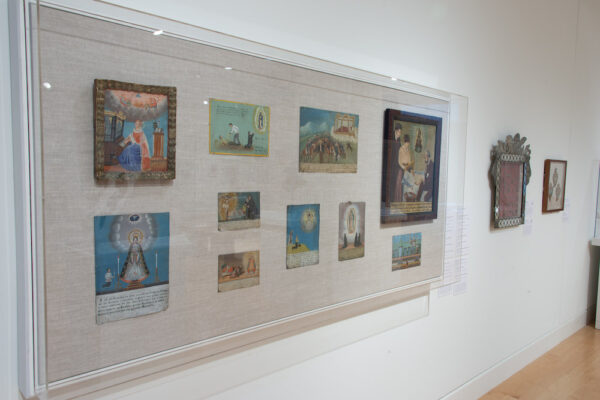
Installation view of Latin American Popular Art Gallery at San Antonio Museum of Art, 2020. All photos courtesy SAMA
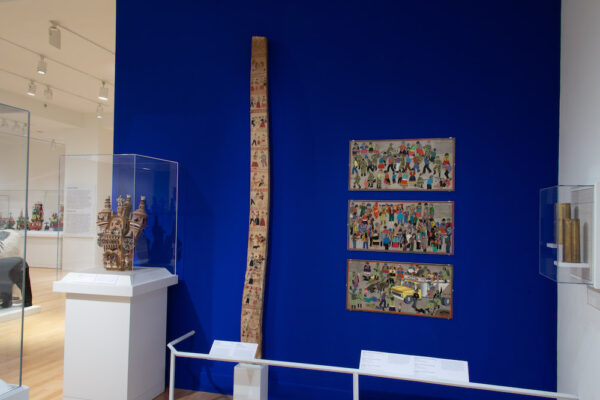
Installation view of Latin American Popular Art Gallery at San Antonio Museum of Art, 2020. All photos courtesy SAMA
The most affecting and haunting works are painted wood tablets by the Association of Popular Artists of Sarhua, depicting the conflict in the Sarhua region of Peru in the 1980s and 1990s between the right-wing government and the insurgent communist guerrilla group The Shining Path. This was a terribly violent conflict where villagers were often caught in the middle. These paintings, with their sharp dimensionality recalling Bruegel, open a lens onto a world that most of us are ignorant of. You don’t have to know the history to intuit the story — the precarity, struggle, violence, and tragedy.
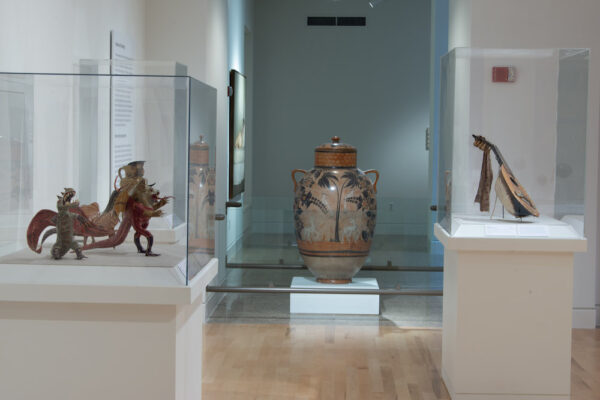
Installation view of Latin American Popular Art Gallery at San Antonio Museum of Art, 2020. All photos courtesy SAMA

Installation view of Latin American Popular Art Gallery at San Antonio Museum of Art, 2020. All photos courtesy SAMA
This dynamic exists and is at play with all the works in this exhibit. You don’t have to know specifics — who the artist was, about the region it originated, what cultural references are incorporated — to sense somehow. Such is the magic of “popular” art — it does not look down from a pedestal, but leads one by the hand up the winding roads to the mountains.
San Antonio Museum of Art can be found here.


